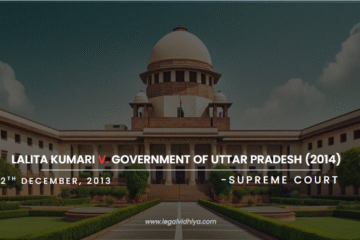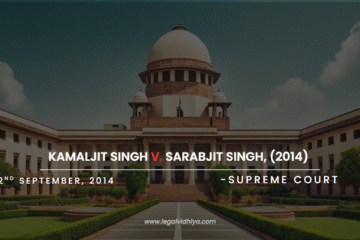
| Case Name | State of Rajasthan v Bheru Lal (2013) 11 SCC 730 |
| Equivalent Citation | AIR 2013 SUPREME COURT 2288, 2013 (11) SCC 730 |
| Date Of Judgement | 28.05.2013 |
| Court | Supreme Court of India |
| Appellant | State of Rajasthan |
| Respondent | Bheru Lal |
| Bench | Honourable Justice Dipak Misra, Honourable Justice B.S. Chauhan |
FACTS:
- Pravin Vyas, temporary in-charge S.H.O of Chittorgarh police station along with two other police officers on relevant information and with relevant permission laid trap at Sarhad Kheri Road, and seized Bheru Lal with two plastic bag, each carried with 3kgs of Opium. Thereafter, due procedures were conducted, and after complete investigation charge-sheet was placed for the offences punishable under Sections 8/18 of the Act.
- The accused pleaded false implication and claimed to be tried, and denied the charges.
- At the trial court, the learned trial Judge, after analyzing the evidence and other relevant materials brought on record, and considering the contention from the both prosecution and defence counsel, found the accused guilty of the offence punishable under sections 8/18 of the Act and sentenced the accused of rigorous imprisonment of 10 years and to pay a fine of 1 lakh rupees.
- The conviction was challenged and was further appealed by the respondent to the High Court. The principal contention was that, Parveen Vyas was not authorised under Section 42 of the Act to search, seize or arrest a person and hence, the whole trial should be ab initio void. The High Court, then scanned the statutory provision and the Government issued notification and held that Rameshwar Prasad was the only S.H.O and hence, Parveen Vyas did not have the authority to conduct any search, seizure and arrest and this way the whole trial had become void. Thus, the High Court acquitted the accused.
- The case was further appealed to the Supreme Court, where Dr. Manish Singhvi, learned Additional Advocate General for the State of Rajasthan was from the appellant side and Mr. Atul Agarwal, learned counsel appeared for the respondent side.
ISSUES RAISED
- What is exactly interpreted in the section 42 of Narcotic Drugs and Psychotropic Substances Act, 1985?
- Whether he was capable of conducting the search, seizure, and arrest, or if there was a breach of the conditions outlined in Section 42 of the Act, rendering the entire trial null and unlawful?
ARGUMENTS
Petitioner’s Arguments-
- It was contended that, Rameshwar Prasad, Station House Officer of the police station of Chittorgarh, had gone out of the police station and handed over the charge to Mr Parveen Vyas, Sub-Inspector and he had conducted the search and seizure, and hence, there was substantial compliance of the provision in the view of the Constitution Bench decision in Karnail Singh v. State of Haryana.
- There is convincing and trustworthy evidence on file indicating that Rameshwar Prasad handed over control of the Station House Officer to Parveen Vyas, PW-2, after leaving the police station for a specific period of time.
- The experienced single judge has acknowledged that Rameshwar Prasad, PW-9, temporarily placed him in charge of the Station House Officer. Nevertheless, he had seen that he was not assigned to the police station’s Station House Officer position, and by the time the search and seizure occurred, it was about 8:00 p.m.
- If the Act’s statutory requirement to write down the information under Sections 41(2) and 42(2) is seen as a requirement, it will hinder the urgency of an emergency situation and might prove to be ineffective in terms of illegal search and seizure.
- It is not appropriate for wrongdoers or criminals to abuse these rules as a primary justification for acquittal. Therefore, rather than giving seasoned drug dealers a way out, these provisions should be viewed as a discretionary mechanism that should check the exploitation of the Act.
Respondent’s Arguments-
- It was contended that Since Praveen Vyas is not the permanent S.H.O., he is not entitled to conduct searches and seizures. As a result, the verdict of acquittal cannot be faulty. Only Sub Inspectors of Police who are assigned as Station House Officers are permitted to conduct searches and seizures.
- It is essential to review the unamended Section 42 of the Act in order to understand the opposing views made at the Bar, since the aforementioned provision was in effect at the relevant period. Act 9 of 2001 has replaced the Act’s original Section 42, and it went into force on October 2, 2001.
JUDGEMENT/ANALYSIS
Regarding the issue, the court held that, The High Court’s decision is overturned, and the trial judge’s well-reasoned decision is reinstated. The respondent must be arrested in order for the learned trial judge to carry out the remainder of his sentence.
It is acknowledged that at the pertinent period, Parveen Vyas, PW-2, was temporarily assigned as the Station House Officer. He got the facts from the trustworthy source. He fulfilled the remaining prerequisites and moved forward to the accused’s location to trap them. Any waiting would have given the accused time to get away. The notification states that a Sub Inspector of Police may be assigned to the position of Station House Officer, and PW-2 was in charge of the position at the relevant period. There’s no reason to give the word “posted” more weight than is required. At that point, he was really in charge of the position of Station House Officer. Our opinion is that the principle established by the Constitution Bench in the Karnail Singh case would be undermined by taking such a literal and technical approach. Consequently, the trial would not be nullified from the beginning due to the search, seizure, and arrest that he conducted.
CONCLUSION
This case focused on the severity of the commitment of crime, rather than focusing on who was authorized to conduct the investigation. It emphasised on that there is no escape from the crime, if you have done a really wrong thing, you should be punished. This case held the rule of law and considered the severity of the crime.
REFERENCE
https://indiankanoon.org/doc/192611261
This Article is written by Shruti Suman, student of Thakur Ramnarayan College Of Law, Mumbai University.
Disclaimer: The materials provided herein are intended solely for informational purposes. Accessing or using the site or the materials does not establish an attorney-client relationship. The information presented on this site is not to be construed as legal or professional advice, and it should not be relied upon for such purposes or used as a substitute for advice from a licensed attorney in your state. Additionally, the viewpoint presented by the author is of a personal nature.




0 Comments